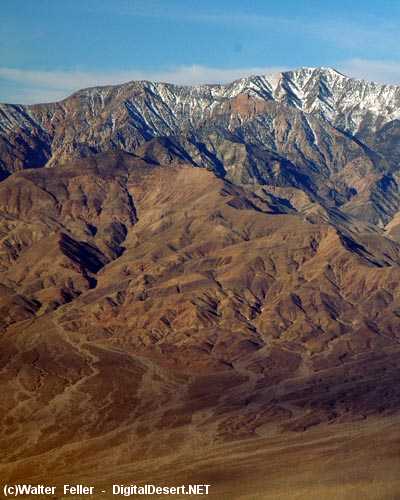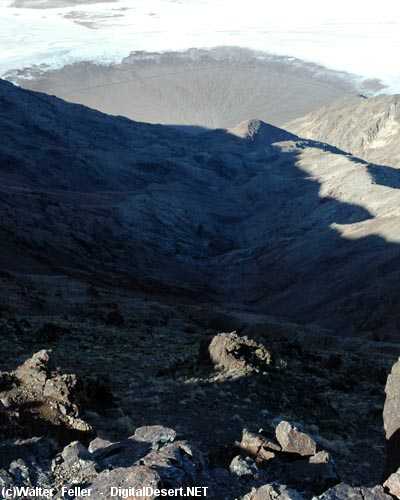--
Alluvial Fans
The work of water: Alluvial fansFrom the mouth of Golden Canyon, the top of Artist's Drive, or Dante's View, you have a sweeping view across Death Valley toward the Panamint Mountains. Rising almost halfway up the steep mountain front of the Panamints are great aprons of rocky debris that spread out toward the deep valley floor, partially burying this majestic range in its own sediment. If you're observant, you'll notice that the sediment apron is actually made up of many individual fan-shaped deposits, each radiating out from a deep canyon cut into the mountain front. Death Valley is world-famous for the incredible size, shape, and exposure of these alluvial fans. Although rainfall is scarce in the valley, water is the creative force that builds Death Valley's alluvial fans. At higher elevations, precipitation is higher, and the water is quickly channeled into the canyons that drain the mountain front. Death Valley's occasional, but intense, storms can quickly flood these canyons, sending surges of water downslope. Where this deluge passes through narrow canyon passageways, the water flow rapidly gains speed and strength (just like placing your thumb over a garden hose creates a spray). The raging water picks up any loose material in its path. The faster the water moves, the larger the pieces of rock it picks up.
Dumping debris
Eventually the rock-laden torrent reaches the narrow canyon mouth. Water rushes out of the canyon into the open valley. Without the constricting force of the canyon walls, the racing flood water slows down dramatically, loses energy, begins to drop its sediment load, and breaks into several small streams. The largest rocks drop out first, and the smallest sediment is carried farthest from the canyon mouth. Only the finest silts and clays are carried all the way to the bottom of Death Valley.
Each flood deposits an new batch of sediment. In areas with higher rainfall, running streams would remove this dumped debris, but in dry Death Valley, much of it stays put. When the next flood washes down the canyon, it may take a new path to the valley bottom. Over time, a system of braided stream channels radiates out from the canyon mouth, and gradually builds up an alluvial fan.
Old and new
From overlooks like Dante's View, you can easily see braided networks of light grey channels emanating from canyon mouths and extending to the valley floor. These light grey washes are the active channels of the alluvial fan. Older, inactive channels have been darkened by desert varnish. As Death Valley deepens and tilts, older alluvial fan channels are permanently abandoned, while new channels cut deep trenches on their way to the base of the fan. Even the casual observer can often identify several generations of fan deposits, the darkest, most deeply desert varnished are the oldest, while the lightest are youngest.
Radiocarbon dates indicate that the highest surviving fan surfaces in Death Valley are about 50,000 years old. No doubt countless fans have formed since the opening of Death Valley about 3 million years ago, but those earlier fan deposits are now buried thousands of feet beneath younger fans and the valley floor.
| GLOSSARY | > alluvium, deposition, desert varnish, sediments |

Alluvial fans at base of Telescope Peak.

Badwater alluvial fan as viewed from Dante's View
Also see:
Pediments & Alluvial Fan Formation